Parameterization of Dust Emissions from Heaps and Excavations Based on Measurement Results and Mathematical Modelling
Abstract
:1. Introduction
- What are the PM emissions from heaps and do they align with the functions from literature sources?
- What are the differences in heap-based emissions between vehicle activity and undisturbed conditions?
- What is the impact of new source functions on emissions modelled on the national scale?
- Is the proposed new methodology for parametrization and calculating emissions from heaps and excavations validated through modelling air quality?
2. Materials and Methods
2.1. Study Area
2.2. Measurement Techniques
2.2.1. Ground Station
- A Gill MetConnect meteorological station measuring air pressure, temperature, humidity, and the wind’s direction and speed. It was placed 2 m agl, with the data recorded at a temporal resolution of 1 s.
- A station for measuring the particle size distribution, equipped with an SPS30 sensor for measuring concentrations of suspended particulate matter (PM2.5 and PM10). The sensor, positioned 2 m above ground level, recorded data at a temporal resolution of 1 s. Additionally, the station recorded the temperature and relative humidity of the air entering the sensor.
- An ultrasonic anemometer (Anemometer TriSonica), positioned at a height of 10 m agl, measuring three components of wind speed at a temporal resolution of 10 Hz.
2.2.2. Flying Measurement Platform
2.3. Parameterization of Emission Fluxes
2.3.1. Description of the Selected Parameterization Method
2.3.2. Theoretical Foundations
2.3.3. Limitations of the Method
2.3.4. Parameterization Calculations Based on the Measurements
2.4. GEM-AQ Model
3. Results
3.1. Variability in the Meteorological Conditions in the Warsaw Region
3.2. The Vertical Variability of Concentrations of PM2.5, PM10, and BC
3.3. The Variability in PM2.5 and PM10 Concentrations during Vehicle Movements
3.4. Measurement—Conclusions
3.5. Results of Parameterization
3.5.1. Description of the Time Series of Flux
3.5.2. Dependence of Flux on Wind Speed—Parametrization of Dust Emissions
3.6. Calculation of Emissions
- Developed parameterization,
- Average daily wind speed fields from the GEM-AQ model for 2022, and
- Outlines of heaps and workings from BDOT.
- No commotion,
- Commotion for 8 h a day but only on working days (252 working days),
- Commotion for 8 h for 365 days, and
- Continuous commotion
- No commotion
- For PM10:
- For PM2.5:
- Commotion for 8 h a day but only on working days (252 working days)
- For PM10:
- For PM2.5
- Commotion for 8 h for 365 days
- For PM10:
- For PM2.5:
- Continuous commotion
- For PM10:
- For PM2.5:
- In all these formulae,FPM10 = 0.0017 × u − 0.0007FPM2.5 = 0.0017 × u – 0.0007FwPM10 (u > 2.5 m/s) = 0.0272 × u + 0.0038FwPM10 (u < 2.5 m/s) = 0.0049 × u + 0.0582where u is the average daily speed for the selected object (m/s) and A is the area of the selected object (m2).FwPM2.5 = 0.0041 × u − 0.0492
3.7. Modelling Results
4. Discussion
5. Conclusions
Author Contributions
Funding
Data Availability Statement
Conflicts of Interest
References
- Manisalidis, I.; Stavropoulou, E.; Stavropoulos, A.; Bezirtzoglou, E. Environmental and Health Impacts of Air Pollution: A Review. Front. Public Health 2020, 8, 505570. [Google Scholar] [CrossRef] [PubMed]
- Lelieveld, J.; Evans, J.S.; Fnais, M.; Giannadaki, D.; Pozzer, A. The contribution of outdoor air pollution sources to premature mortality on a global scale. Nature 2015, 525, 367–371. [Google Scholar] [CrossRef] [PubMed]
- Künzli, N.; Kaiser, R.; Medina, S.; Studnicka, M.; Chanel, O.; Filliger, P.; Herry, M.; Horak, S., Jr.; Puybonnieux-Texier, V.; Quénel, P.; et al. Public-health impact of outdoor and traffic-related air pollution: A European assessment. Lancet 2000, 356, 795–801. [Google Scholar] [CrossRef] [PubMed]
- Agency, E.E. Air Quality in Europe 2022; Web Report; European Environment Agency: Copenhagen, Denmark, 2022.
- José, R.S.; Baklanov, A.; Sokhi, R.S.; Karatzas, K.; Pérez, J.L. Air Quality Modeling. Encycl. Ecol. Five-Vol. Set 2008, 111–123. [Google Scholar] [CrossRef]
- Chang, J.C.; Hanna, S.R. Air quality model performance evaluation. Meteorol. Atmos. Phys. 2004, 87, 167–196. [Google Scholar] [CrossRef]
- Rao, S.T.; Galmarini, S.; Puckett, K. Air quality model evaluation international initiative (AQMEII): Advancing the state of the science in regional photochemical modeling and its applications. Bull. Am. Meteorol. Soc. 2011, 92, 23–30. [Google Scholar] [CrossRef]
- Silveira, C.; Ferreira, J.; Miranda, A.I. The challenges of air quality modelling when crossing multiple spatial scales. Air Qual. Atmos. Health 2019, 12, 1003–1017. [Google Scholar] [CrossRef]
- Kaminski, J.W.; Neary, L.; Struzewska, J.; McConnell, J.C.; Lupu, A.; Jarosz, J.; Toyota, K.; Gong, S.L.; Côté, J.; Liu, X.; et al. GEM-AQ, an on-line global multiscale chemical weather modelling system: Model description and evaluation of gas phase chemistry processes. Atmos. Chem. Phys. 2008, 8, 3255–3281. [Google Scholar] [CrossRef]
- Struzewska, J.; Zdunek, M.; Kaminski, J.W.; Łobocki, L.; Porebska, M.; Jefimow, M.; Gawuc, L. Evaluation of the GEM-AQ model in the context of the AQMEII Phase 1 project. Atmos. Chem. Phys. 2015, 15, 3971–3990. [Google Scholar] [CrossRef]
- Russell, A.; Dennis, R. NARSTO critical review of photochemical models and modeling. Atmos. Environ. 2000, 34, 2283–2324. [Google Scholar] [CrossRef]
- Clappier, A.; Thunis, P. A probabilistic approach to screen and improve emission inventories. Atmos. Environ. 2020, 242, 7823–7830. [Google Scholar] [CrossRef]
- De Meij, A.; Cuvelier, C.; Thunis, P.; Pisoni, E.; Bessagnet, B. Sensitivity of air quality model responses to emission changes: Comparison of results based on four EU inventories through FAIRMODE benchmarking methodology. Geosci. Model Dev. 2024, 17, 587–606. [Google Scholar] [CrossRef]
- Thunis, P.; Kuenen, J.; Pisoni, E.; Bessagnet, B.; Banja, M.; Gawuc, L.; Szymankiewicz, K.; Guizardi, D.; Crippa, M.; Lopez-Aparicio, S.; et al. Emission ensemble approach to improve the development of multi-scale emission inventories. Egusph. Prepr. Repos. 2023, 17, 3631–3643. [Google Scholar] [CrossRef]
- Nazar, W.; Niedoszytko, M. Air Pollution in Poland: A 2022 Narrative Review with Focus on Respiratory Diseases. Int. J. Environ. Res. Public Health 2022, 19, 895. [Google Scholar] [CrossRef] [PubMed]
- Agency, E.E. Poland—Air Pollution Country Fact Sheet. 2023. Available online: https://www.eea.europa.eu/themes/air/country-fact-sheets/2023-country-fact-sheets/poland-air-pollution-country (accessed on 10 May 2024).
- Gawuc, L.; Szymankiewicz, K.; Kawicka, D.; Mielczarek, E.; Marek, K.; Soliwoda, M.; Maciejewska, J. Bottom–up inventory of residential combustion emissions in Poland for national air quality modelling: Current status and perspectives. Atmosphere 2021, 12, 1460. [Google Scholar] [CrossRef]
- National Pollutant Inventory. National Pollutant Inventory Emission Estimation Technique Manual for Mining and Processing of Non-Metallic Minerals Version 2.1; Australian Government: Canberra, Australia, 2012; p. 45.
- Ciszewski, A.; Wojciechowski, K. Metody obliczania stanu zanieczyszczenia powietrza atmosferycznego powodowanego przez źródła powierzchniowe. Ochr. Powietrza 1982, 6, 78–82. [Google Scholar]
- Pastuszka, J.S. Emisja pyłu ze zwałowisk węgla i miału. Ochr. Powietrza I Probl. Odpad. 1996, 30, 43–47. [Google Scholar]
- Zawadzka, O.; Posyniak, M.; Nelken, K.; Markuszewski, P.; Chilinski, M.T.; Czyzewska, D.; Lisok, J.; Markowicz, K.M. Study of the vertical variability of aerosol properties based on cable cars in-situ measurements. Atmos. Pollut. Res. 2017, 8, 968–978. [Google Scholar] [CrossRef]
- Hinds, W.C. Aerosol Technology: Properties, Behaviour, and Measurement of Airborne Particles; Wiley: Hoboken, NJ, USA, 1982. [Google Scholar]
- Monin, A.S.; Obukhov, A.M. Basic laws of turbulent mixing in the surface layer of the atmosphere. Geophys. Inst. Acad. Sci. USSR 1959, 24, 163–187. [Google Scholar]
- Foken, T. Micrometeorology, 2nd ed.; Springer: Berlin/Heidelberg, Germany, 2017. [Google Scholar]
- Mårtensson, E.M.; Nilsson, E.D.; Buzorius, G.; Johansson, C. Eddy covariance measurements and parameterisation of traffic related particle emissions in an urban environment. Atmos. Chem. Phys. 2006, 6, 769–785. [Google Scholar] [CrossRef]
- Johansson, C.; Norman, M.; Gidhagen, L. Spatial & temporal variations of PM10 and particle number concentrations in urban air. Environ. Monit. Assess. 2007, 127, 477–487. [Google Scholar]
- Harrison, R.M.; Dall, M.; Beddows, D.C.S.; Thorpe, A.J.; Bloss, W.J.; Allan, J.D.; Coe, H.; Dorsey, J.R.; Gallagher, M.; Martin, C.; et al. Atmospheric chemistry and physics in the atmosphere of a developed megacity (London): An overview of the REPARTEE experiment and its conclusions. Atmos. Chem. Phys. 2012, 12, 3065–3114. [Google Scholar] [CrossRef]
- Kontkanen, J.; Deng, C.; Fu, Y.; Dada, L.; Zhou, Y.; Cai, J.; Daellenbach, K.R.; Hakala, S.; Kokkonen, T.V.; Lin, Z.; et al. Size-resolved particle number emissions in Beijing determined from measured particle size distributions. Atmos. Chem. Phys. 2020, 20, 11329–11348. [Google Scholar] [CrossRef]
- Farmer, D.K.; Boedicker, E.K.; Debolt, H.M. Dry Deposition of Atmospheric Aerosols: Approaches, Observations, and Mechanisms. Annu. Rev. Phys. Chem. 2020, 72, 375–397. [Google Scholar] [CrossRef]
- Patra, A.K.; Gautam, S.; Kumar, P. Emissions and human health impact of particulate matter from surface mining operation—A review. Environ. Technol. Innov. 2016, 5, 233–249. [Google Scholar] [CrossRef]
- Field, J.P.; Belnap, J.; Breshears, D.D.; Neff, J.C.; Okin, G.S.; Whicker, J.J.; Painter, T.H.; Ravi, S.; Reheis, M.C.; Reynolds, R.L. The ecology of dust. Front. Ecol. Environ. 2010, 8, 423–430. [Google Scholar] [CrossRef]
- Hvistendahl, M. Coal Ash Is More Radioactive than Nuclear Waste By burning away all the pesky carbon and other impurities, coal power plants produce heaps of radiation. Sci. Am. 2007, 13, 104–109. [Google Scholar]
- Knap, L.; Świercz, A.; Graczykowski, C.; Holnicki-Szulc, J. Self-deployable tensegrity structures for adaptive morphing of helium-filled aerostats. Arch. Civ. Mech. Eng. 2021, 21, 159. [Google Scholar] [CrossRef]
- Markuszewski, P.; Petelski, T.; Zielinski, T. Marine aerosol fluxes determined by simultaneous measurements of eddy covariance and gradient method. Environ. Eng. Manag. J. 2018, 17, 261–265. [Google Scholar] [CrossRef]
- Sorbjan, Z. Structure of the Atmospheric Boundary Layer; Prentice Hall: Englewood Cliffs, NJ, USA, 1989. [Google Scholar]
- Plate, E.J. Aerodynamic Characteristics of Atmospheric Boundary Layers; Argonne National Lab., Ill. Karlsruhe University: Karlsruhe, Germany, 1971; Volume 51, pp. 622–623. [Google Scholar]
- Seinfeld, J.H.; Pandis, S.N. Atmospheric Chemistry and Physics: From Air Pollution to Climate Change, 3rd ed.; Wiley: Hoboken, NJ, USA, 2016. [Google Scholar]
- McRae, G.J.; Goodin, W.R.; Seinfeld, J.H. Numerical solution of the atmospheric diffusion equation for chemically reacting flows. J. Comput. Phys. 1982, 45, 1–42. [Google Scholar] [CrossRef]
- Côté, J.; Gravel, S.; Méthot, A.; Patoine, A.; Roch, M.; Staniforth, A. The operational CMC-MRB global environmental multiscale (GEM) model. Part I: Design considerations and formulation. Mon. Weather Rev. 1998, 126, 1373–1395. [Google Scholar] [CrossRef]
- Venkatram, A.; Karamchandani, P.K.; Misra, P.K. Testing a comprehensive acid deposition model. Atmos. Environ. 1988, 22, 737–747. [Google Scholar] [CrossRef]
- Struzewska, J.; Kaminski, J.W. Impact of urban parameterization on high resolution air quality forecast with the GEM—AQ model. Atmos. Chem. Phys. 2012, 12, 10387–10404. [Google Scholar] [CrossRef]
- Struzewska, J.; Kaminski, J.W. Formation and transport of photooxidants over Europe during the July 2006 heat wave—Observations and GEM-AQ model simulations. Atmos. Chem. Phys. 2008, 8, 721–736. [Google Scholar] [CrossRef]
- Struzewska, J.; Kaminski, J.W.; Jefimow, M. Application of model output statistics to the GEM-AQ high resolution air quality forecast. Atmos. Res. 2016, 181, 186–199. [Google Scholar] [CrossRef]
- Tagaris, E.; Sotiropoulou, R.E.P.; Gounaris, N.; Andronopoulos, S.; Vlachogiannis, D. Effect of the Standard Nomenclature for Air Pollution (SNAP) categories on air quality over europe. Atmosphere 2015, 6, 1119–1128. [Google Scholar] [CrossRef]
- Kljun, N.; Calanca, P.; Rotach, M.W.; Schmid, H.P. A simple two-dimensional parameterisation for Flux Footprint Prediction (FFP). Geosci. Model Dev. 2015, 8, 3695–3713. [Google Scholar] [CrossRef]
- Fortuniak, K. Funkcja śladu i obszar źródłowy strumieni turbulencyjnych—Podstawy teoretyczne i porównanie wybranych algorytmów na przykładzie Łodzi. Pr. Geogr. Inst. Geogr. i Gospod. Przestrz. Uniw. Jagiellońskiego 2009, 122, 9–22. [Google Scholar]
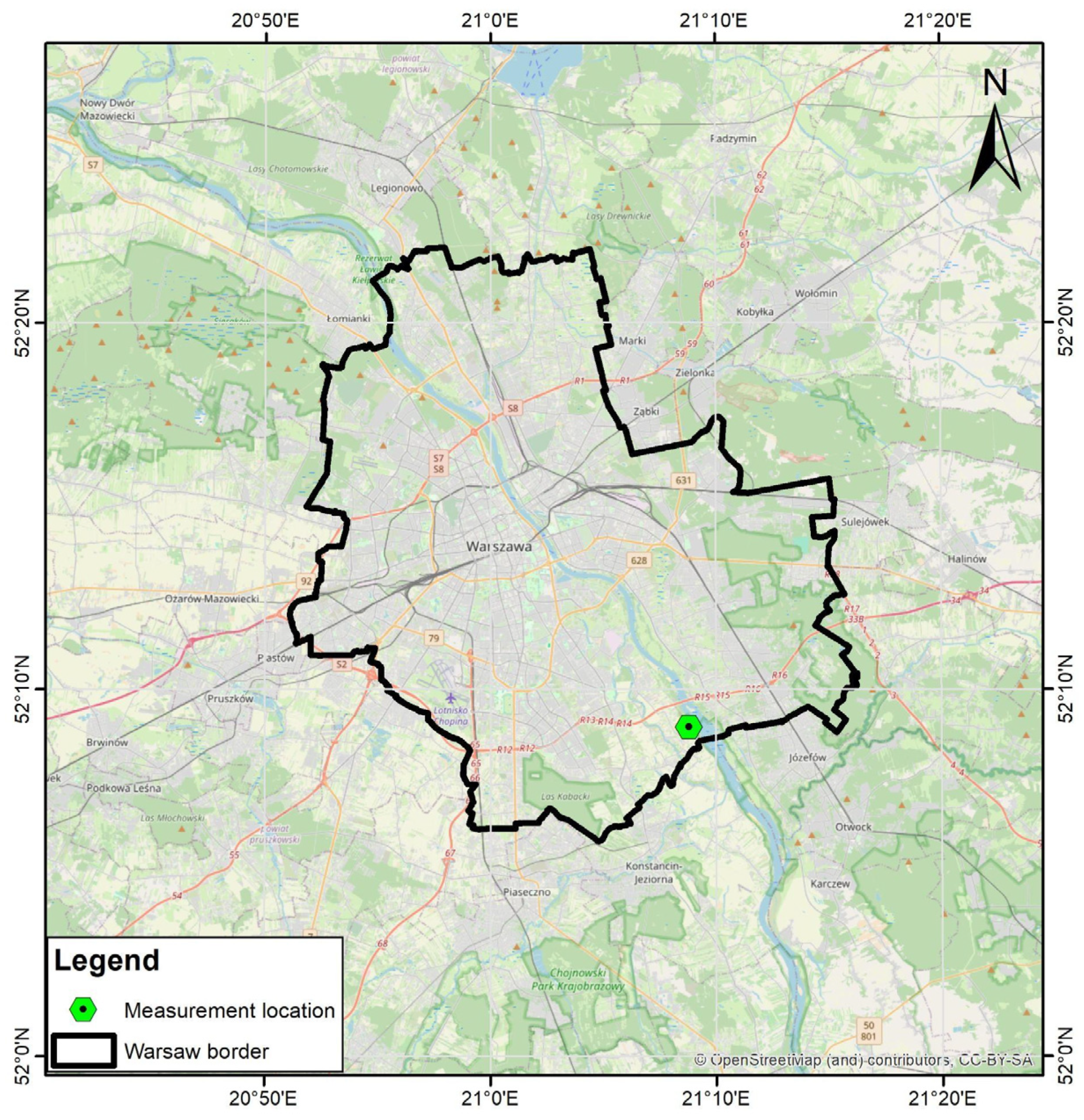
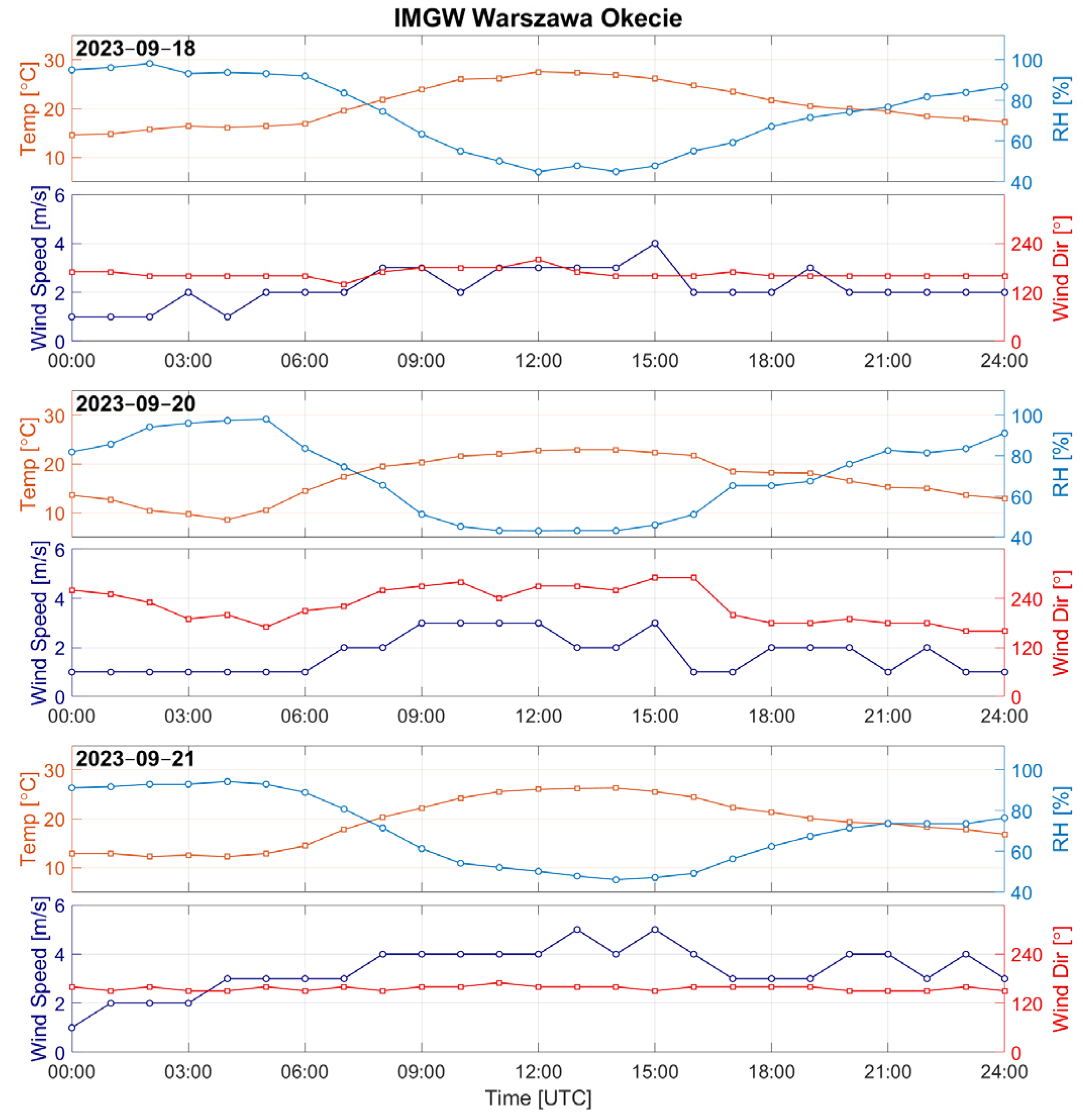
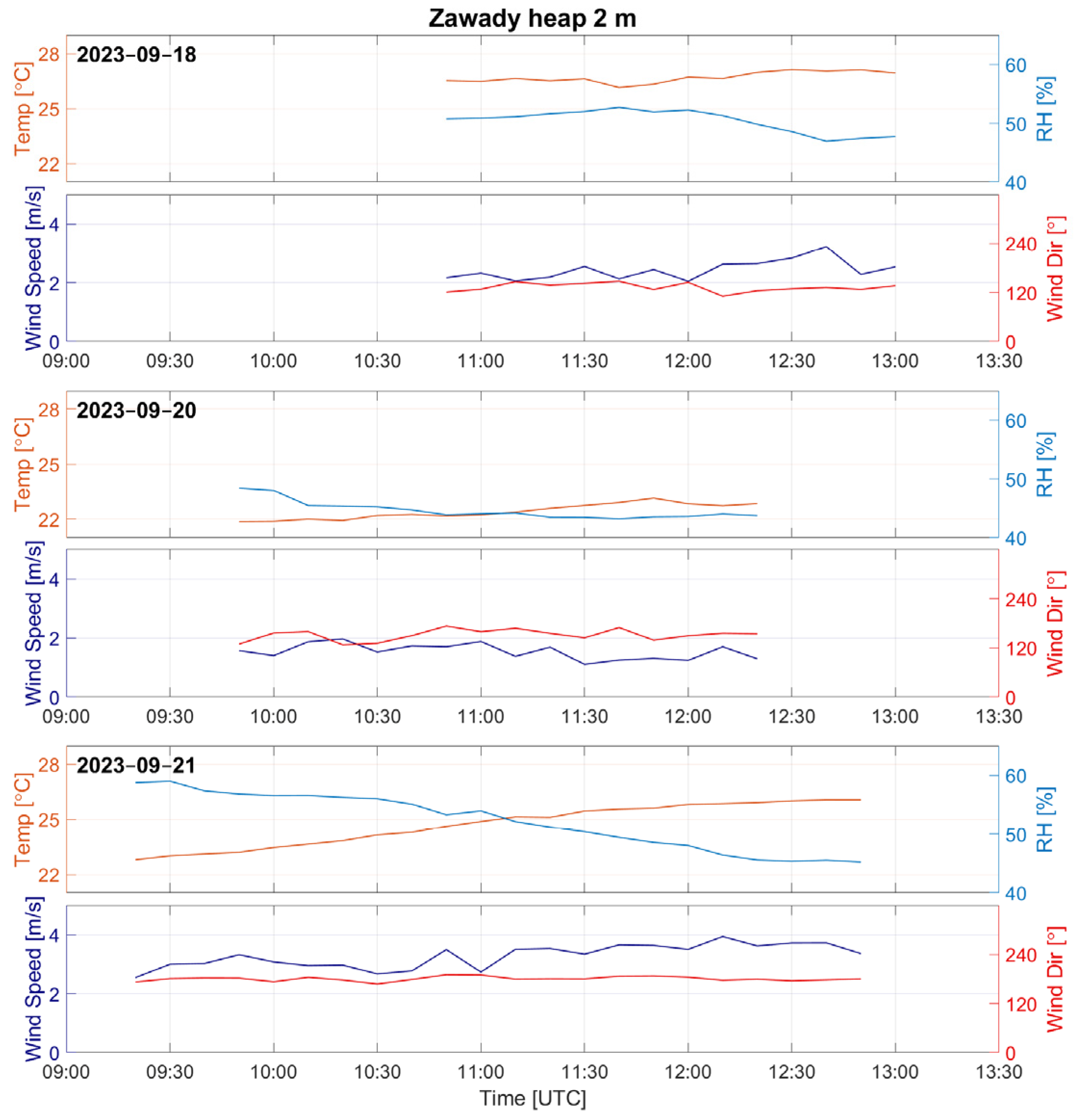
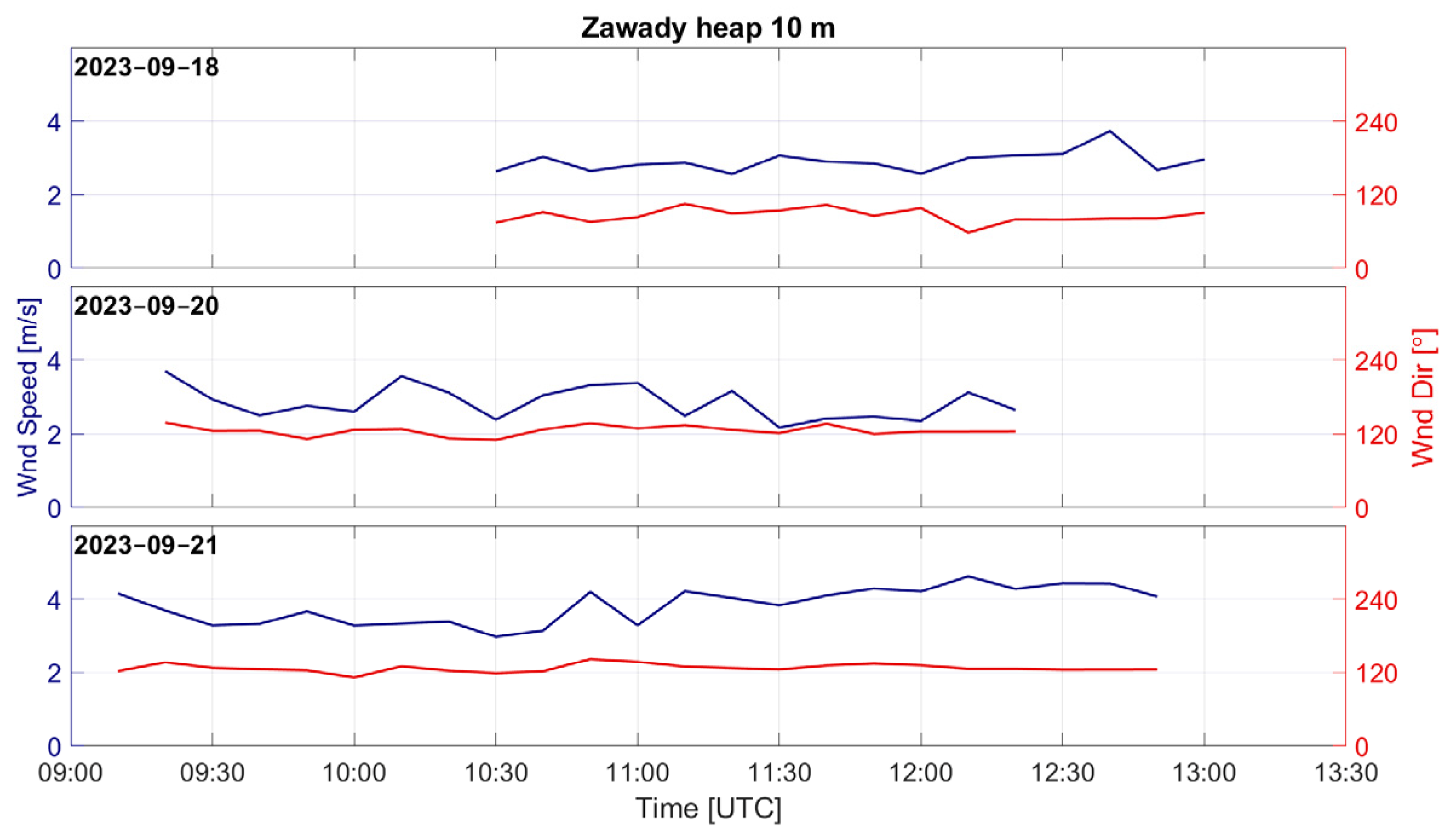
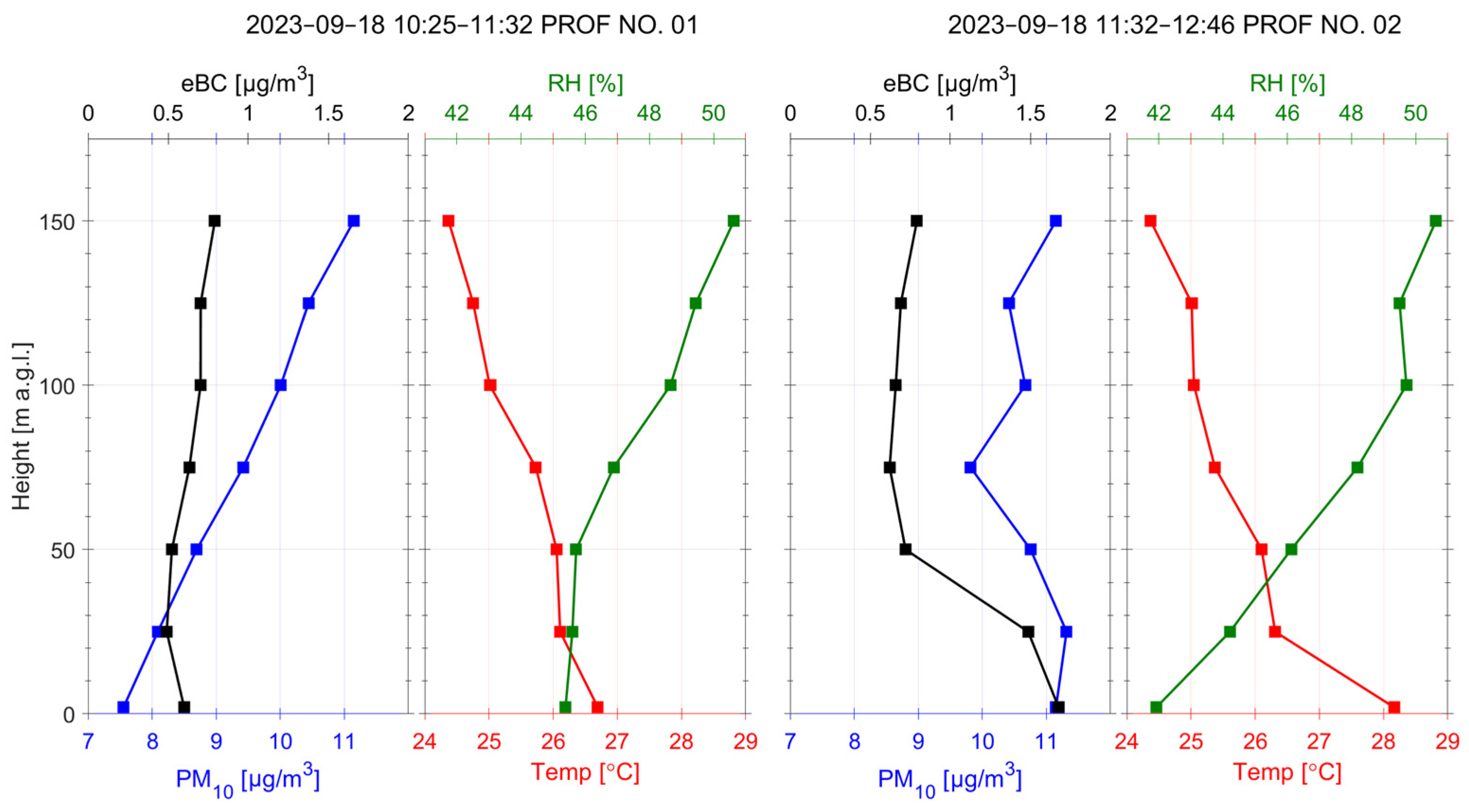
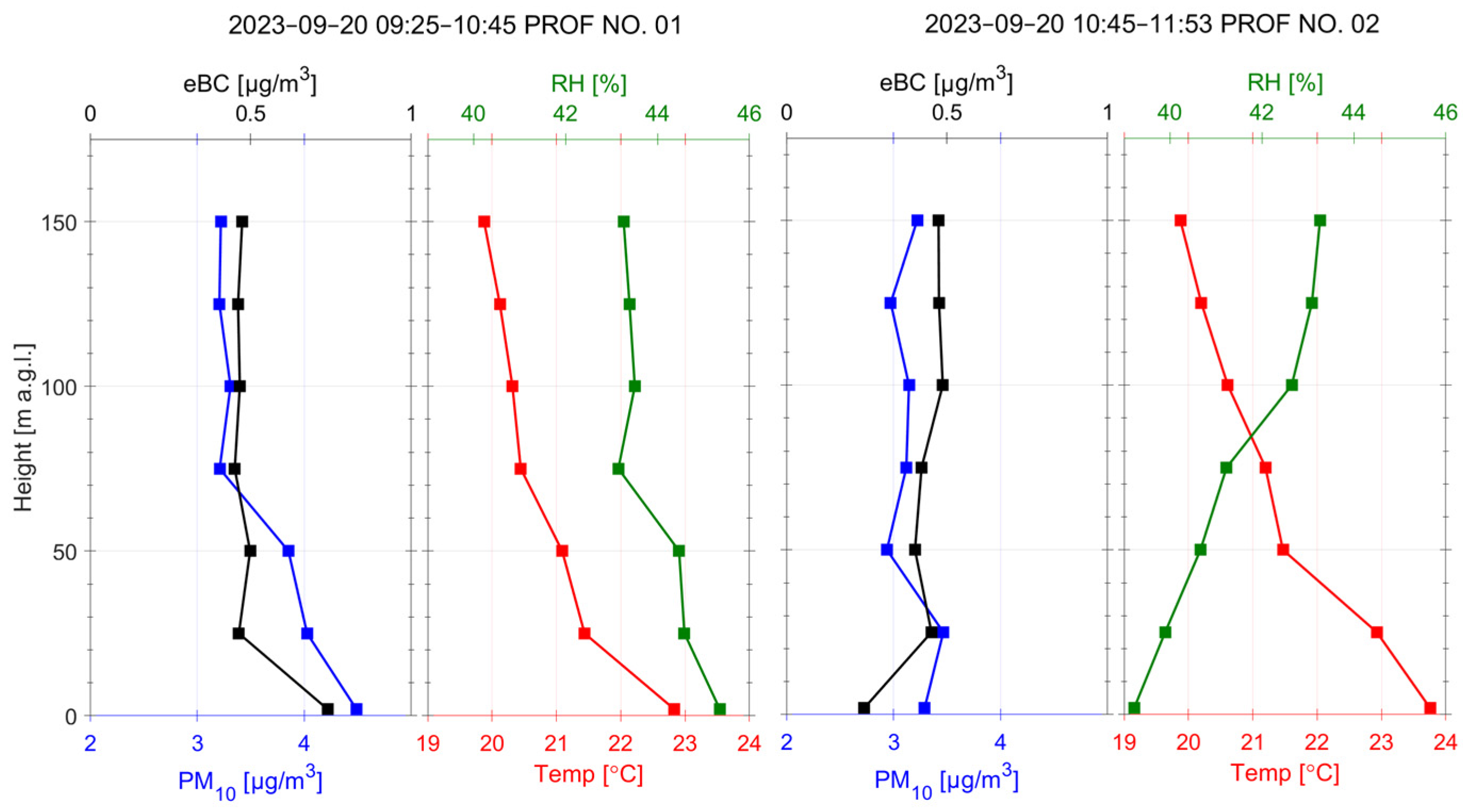
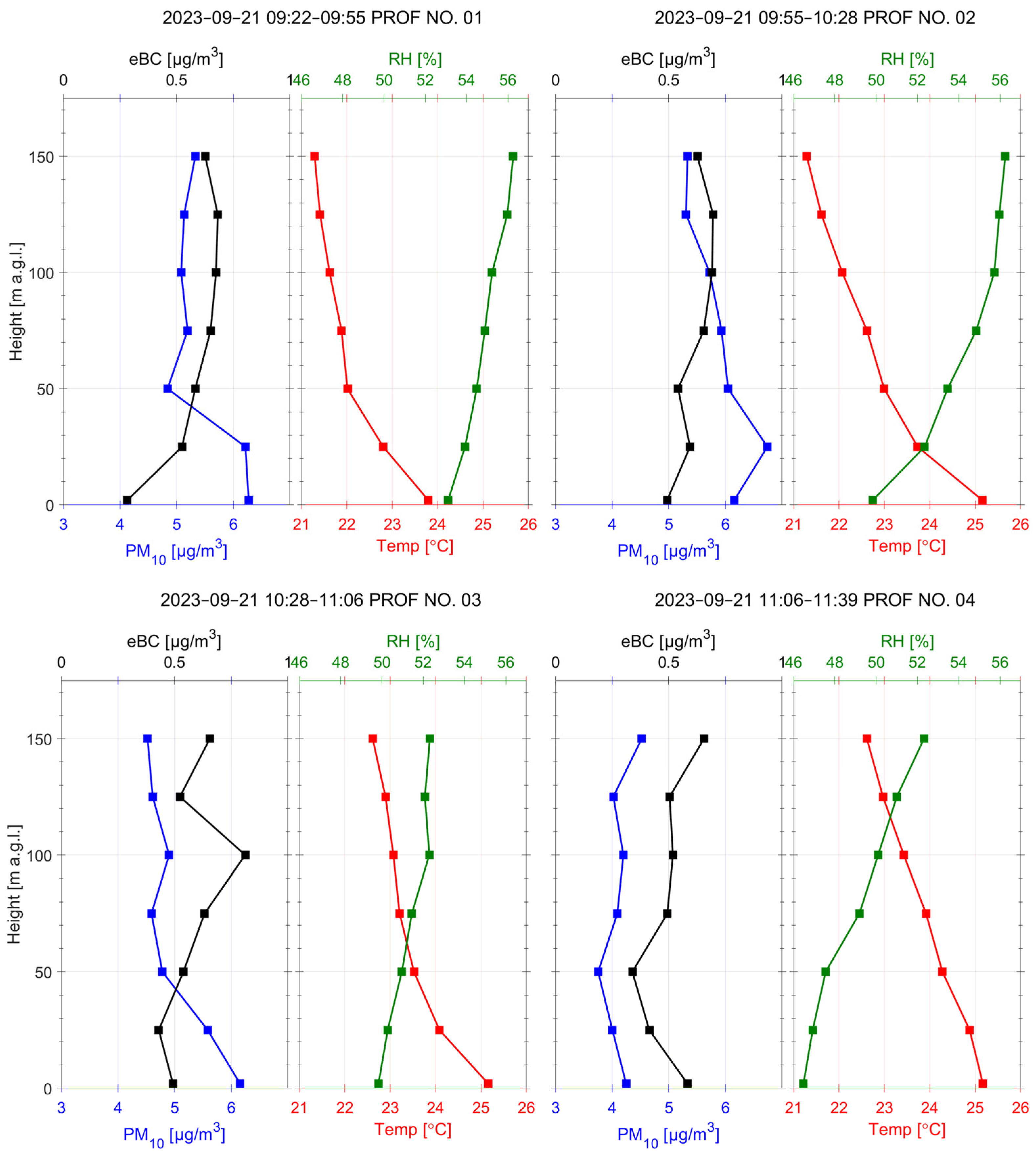
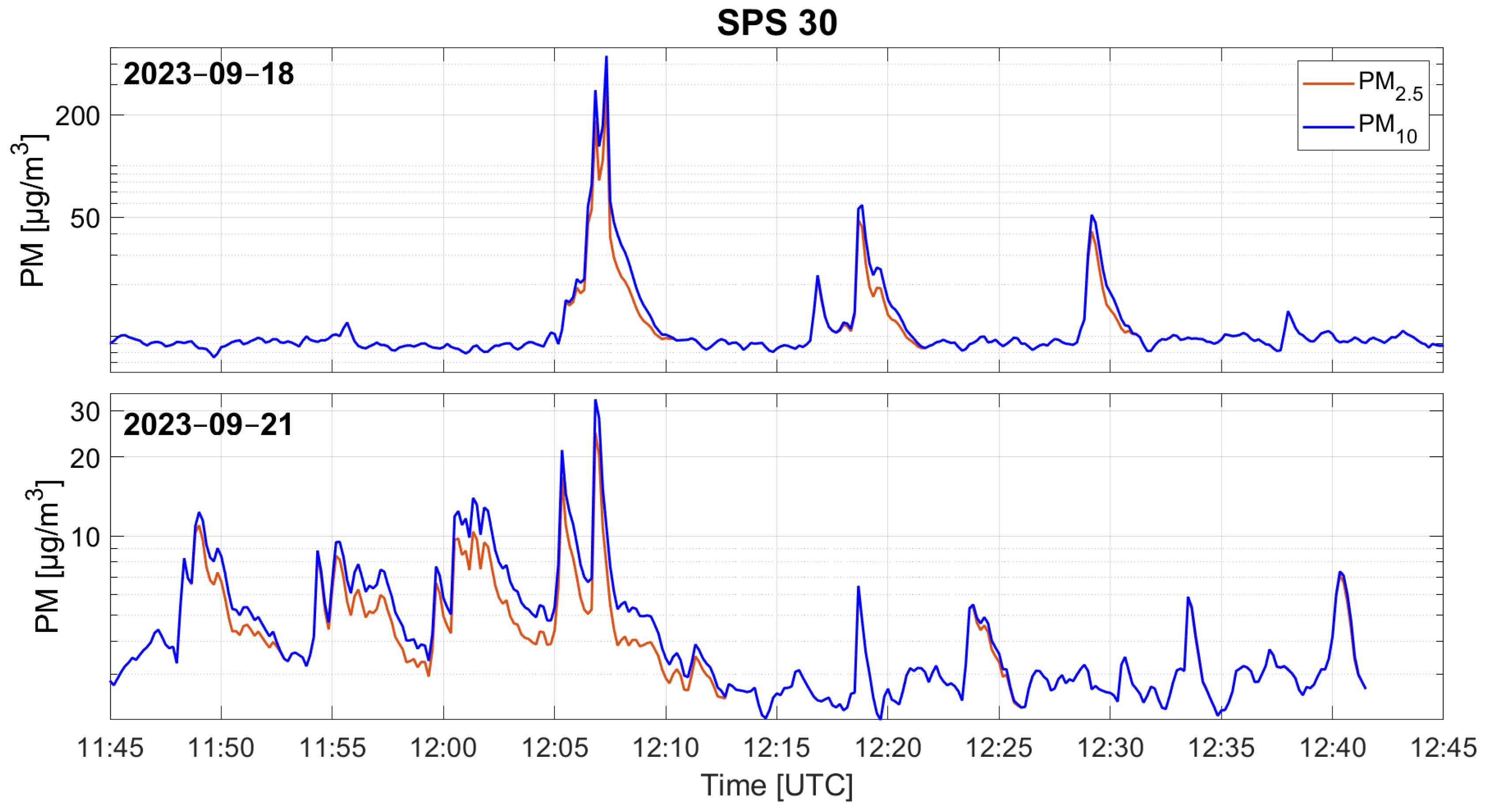
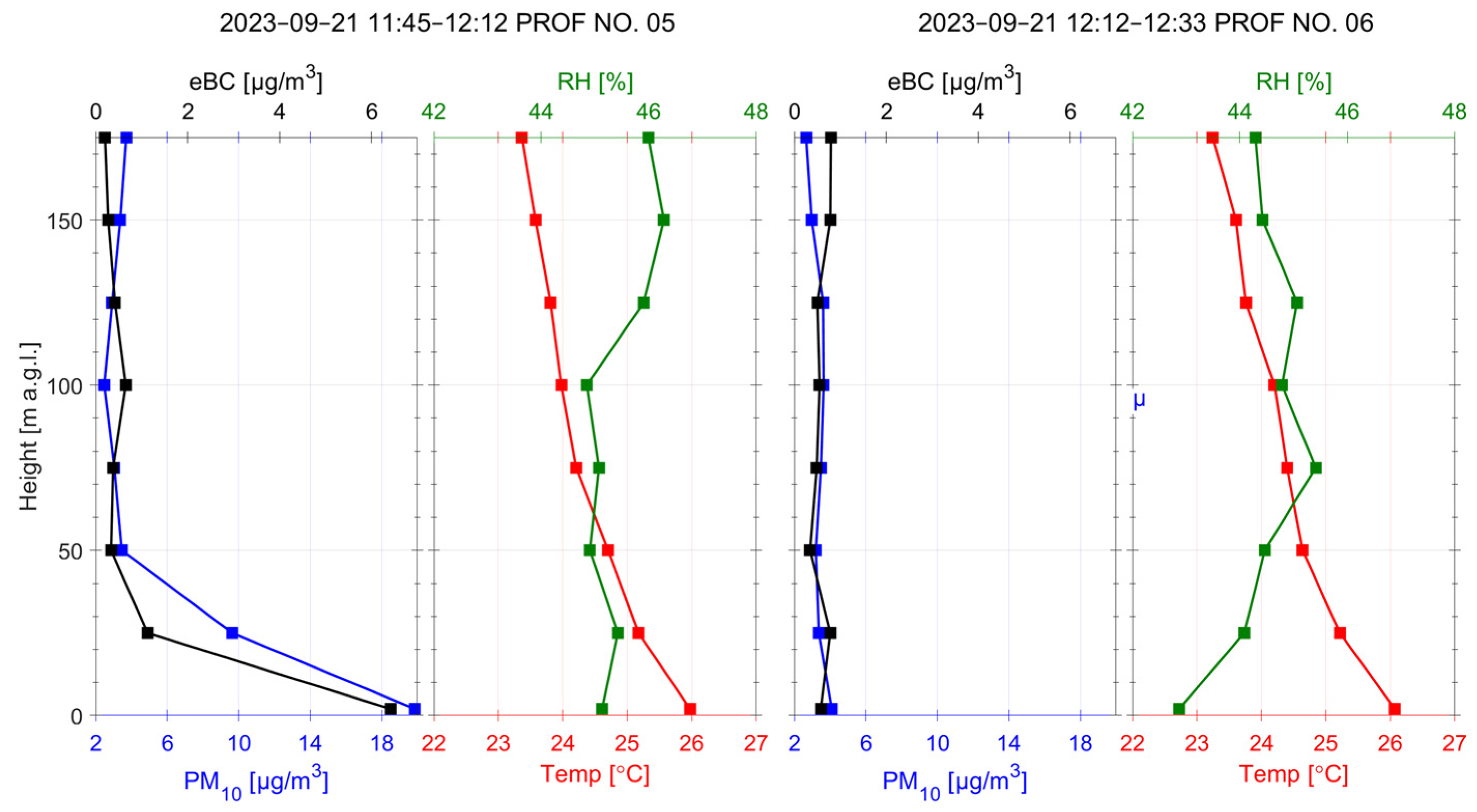
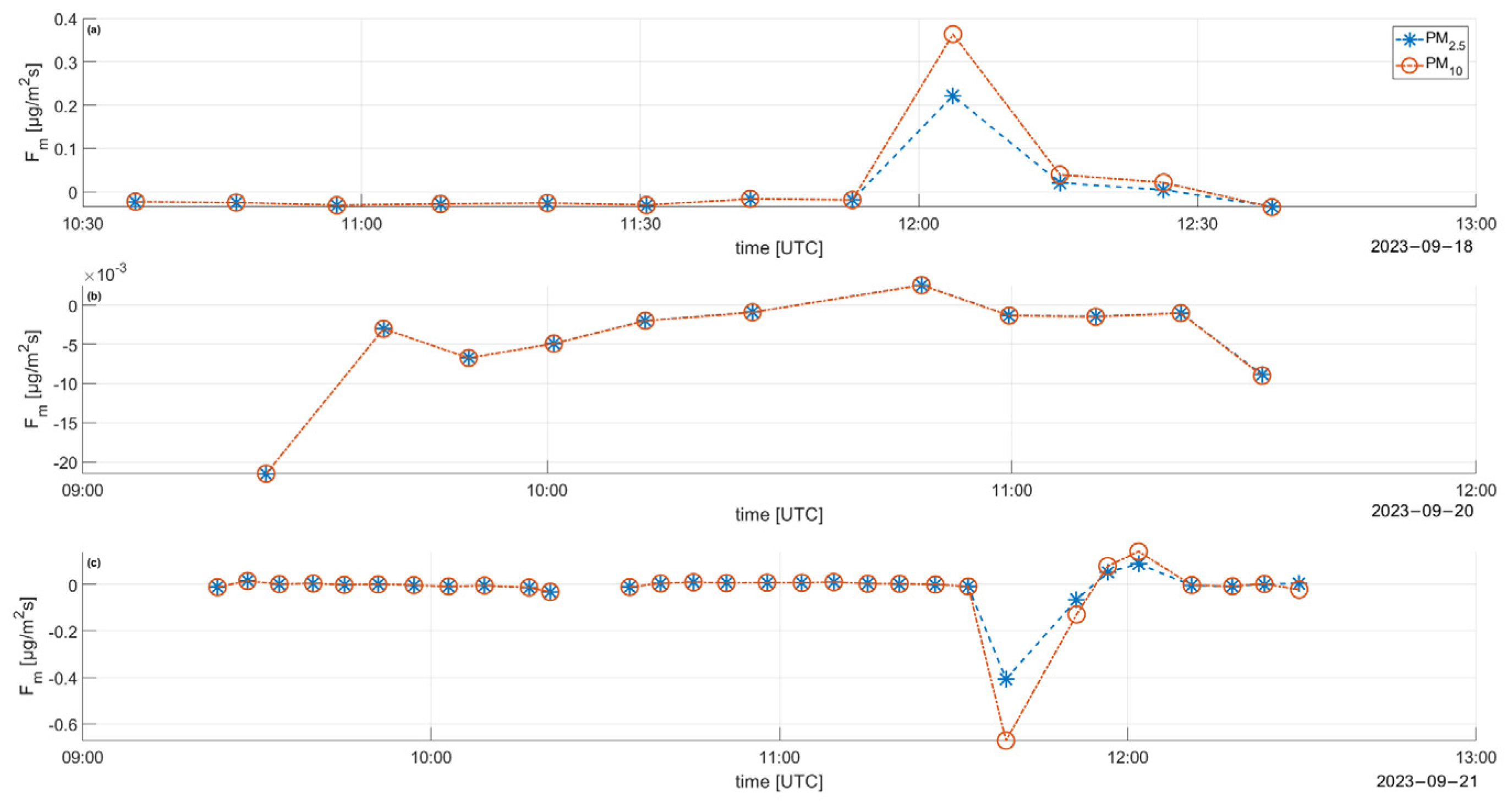

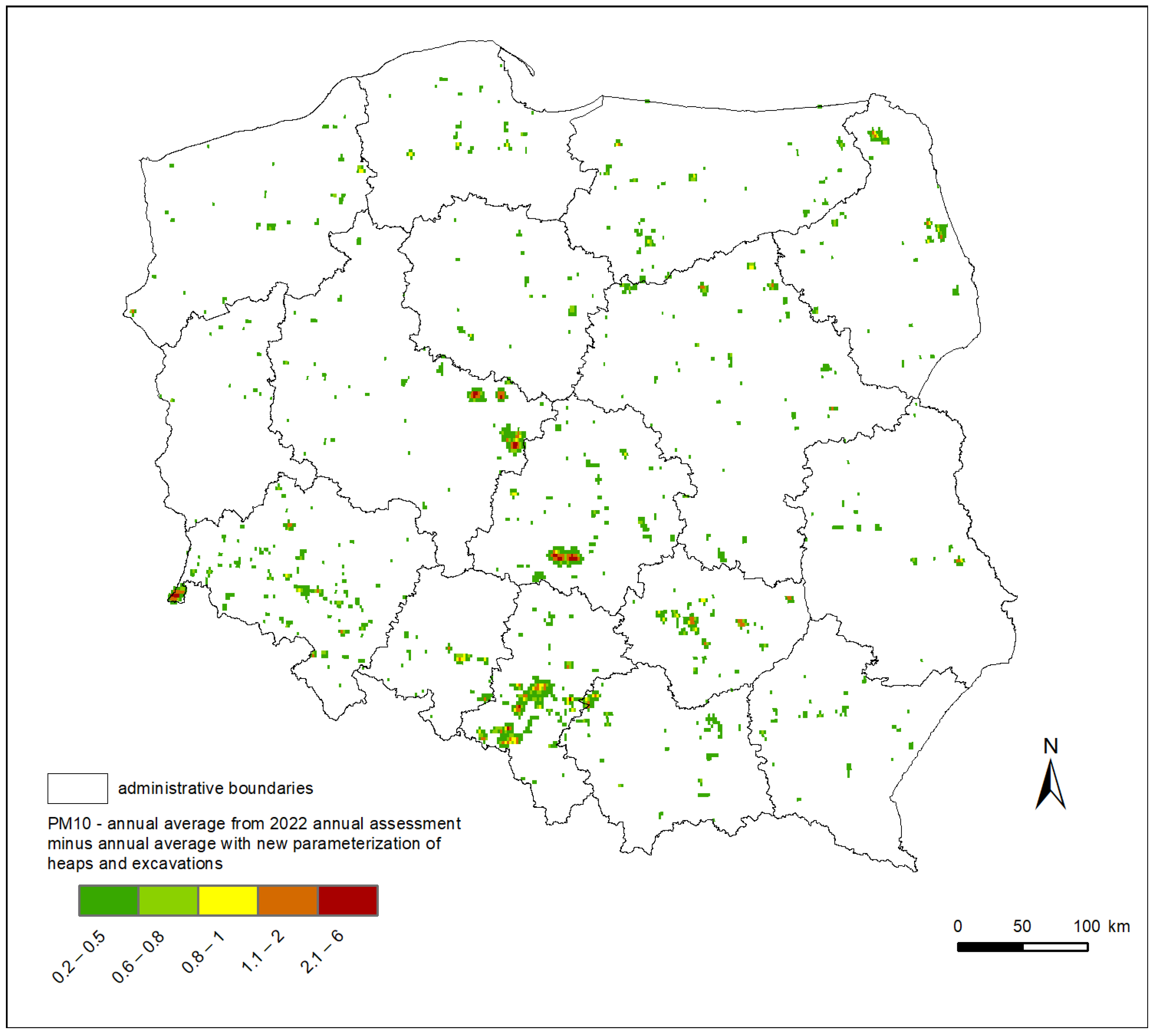
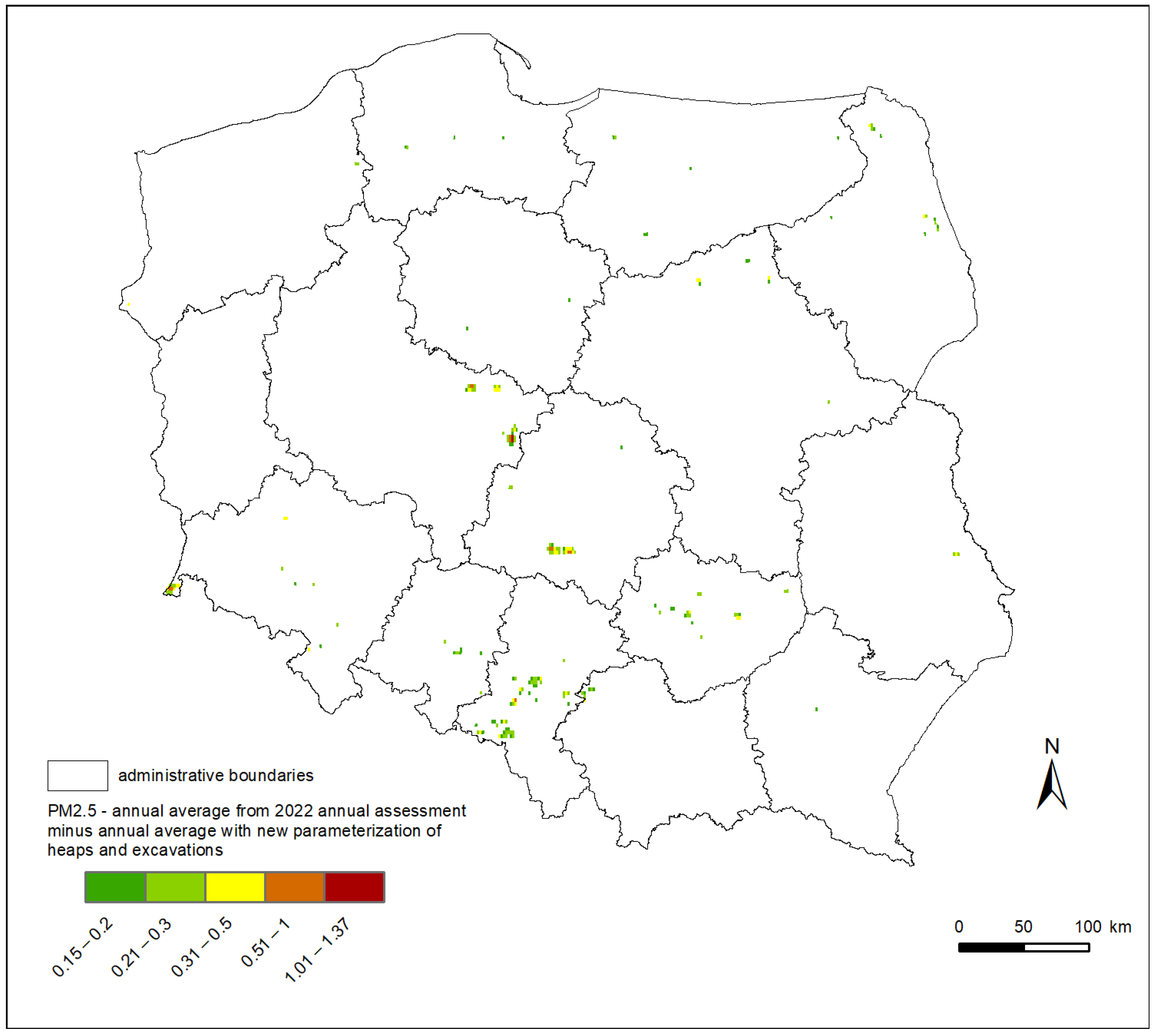


| ax | bx | |
|---|---|---|
| FPM10 (u) | 0.0017 | −0.0007 |
| FPM2.5 (u) | 0.0017 | −0.0007 |
| FwPM10 (u > 2.5 m/s) | 0.0272 | 0.0038 |
| FwPM10 (u < 2.5 m/s) | 0.0049 | 0.0582 |
| FwPM2.5 (u) | 0.0041 | 0.0492 |
| Emission Scenarios | PM10 [kg] | PM2.5 [kg] |
|---|---|---|
| No commotion | 42,470 | 42,470 |
| Commotion for 8 h a day but only on working days (252 working days) | 236,364 | 217,674 |
| Commotion for 8 h for 365 days | 399,946 | 297,921 |
| Continuous commotion | 886,289 | 803,893 |
| CED 2022 | 9,493,354 | 2,283,012 |
Disclaimer/Publisher’s Note: The statements, opinions and data contained in all publications are solely those of the individual author(s) and contributor(s) and not of MDPI and/or the editor(s). MDPI and/or the editor(s) disclaim responsibility for any injury to people or property resulting from any ideas, methods, instructions or products referred to in the content. |
© 2024 by the authors. Licensee MDPI, Basel, Switzerland. This article is an open access article distributed under the terms and conditions of the Creative Commons Attribution (CC BY) license (https://creativecommons.org/licenses/by/4.0/).
Share and Cite
Szymankiewicz, K.; Posyniak, M.; Markuszewski, P.; Durka, P. Parameterization of Dust Emissions from Heaps and Excavations Based on Measurement Results and Mathematical Modelling. Remote Sens. 2024, 16, 2447. https://doi.org/10.3390/rs16132447
Szymankiewicz K, Posyniak M, Markuszewski P, Durka P. Parameterization of Dust Emissions from Heaps and Excavations Based on Measurement Results and Mathematical Modelling. Remote Sensing. 2024; 16(13):2447. https://doi.org/10.3390/rs16132447
Chicago/Turabian StyleSzymankiewicz, Karol, Michał Posyniak, Piotr Markuszewski, and Paweł Durka. 2024. "Parameterization of Dust Emissions from Heaps and Excavations Based on Measurement Results and Mathematical Modelling" Remote Sensing 16, no. 13: 2447. https://doi.org/10.3390/rs16132447






